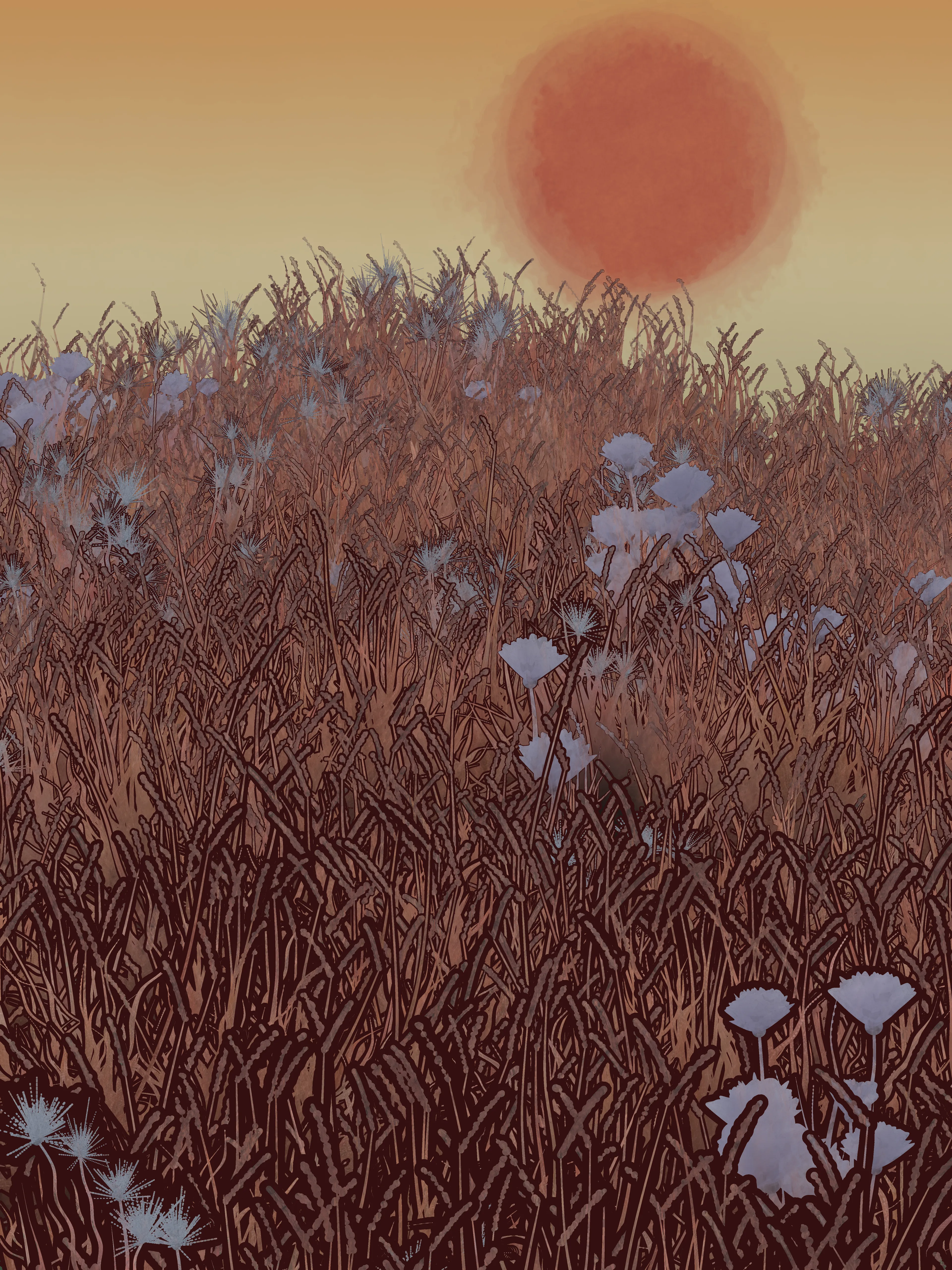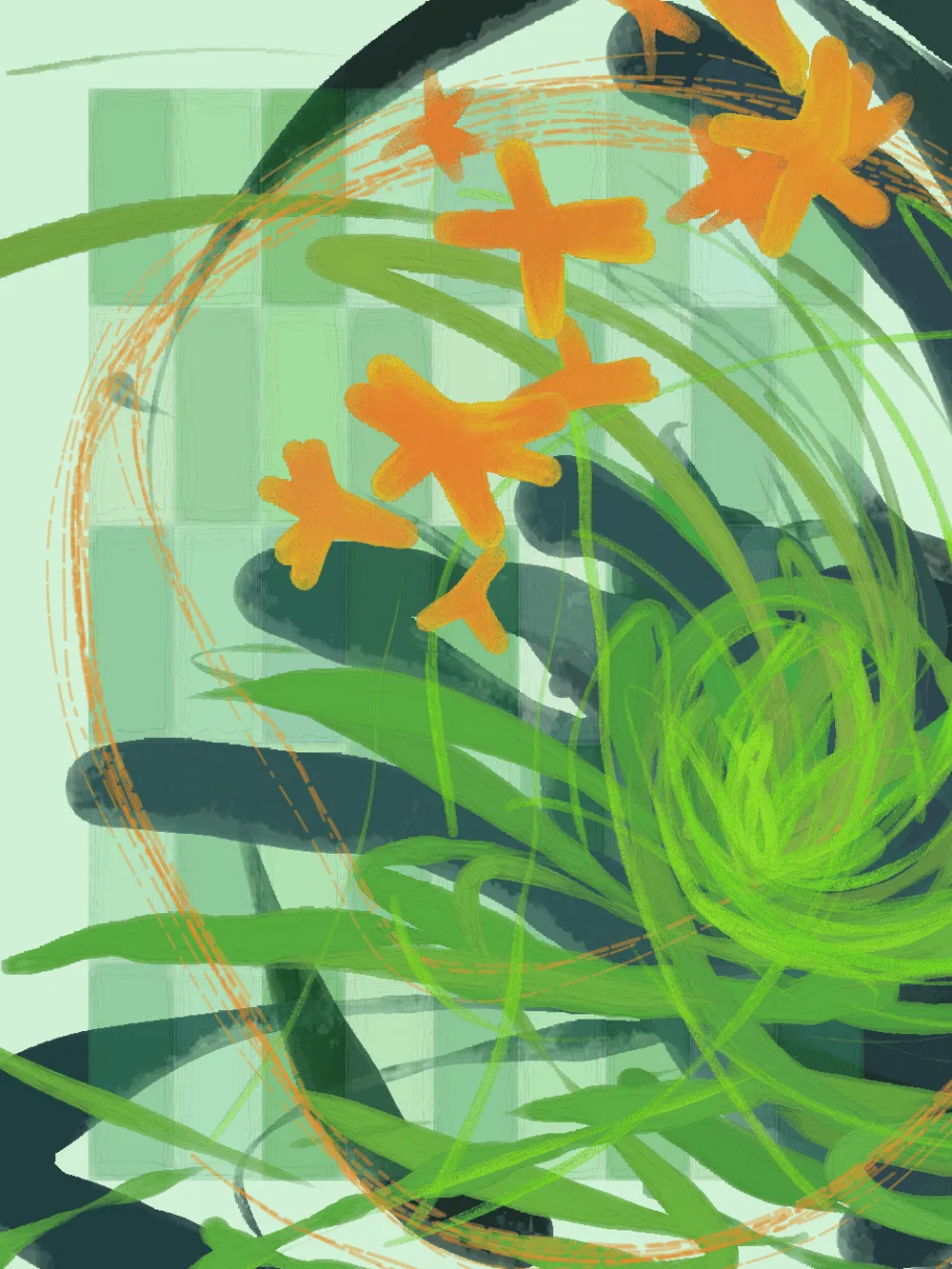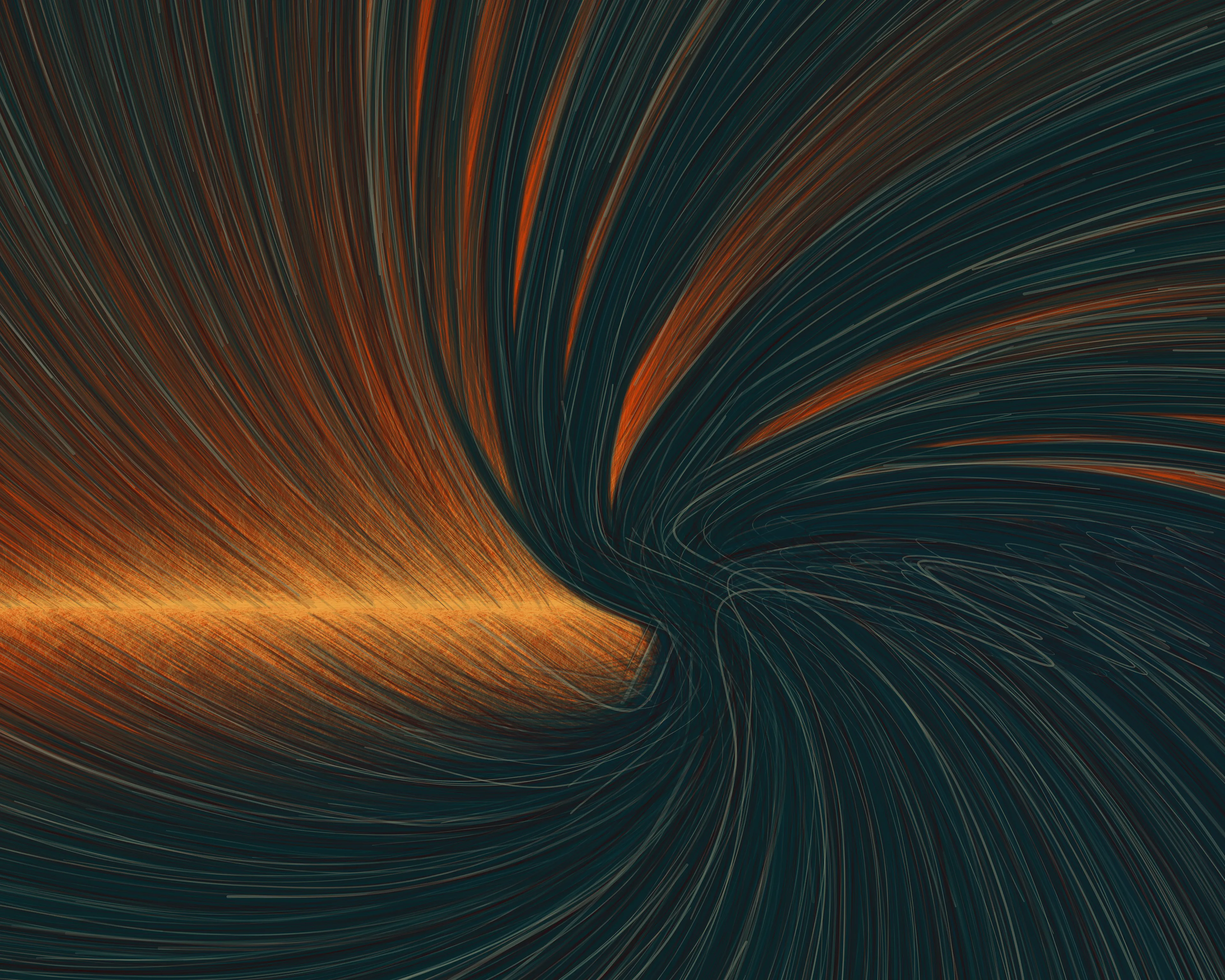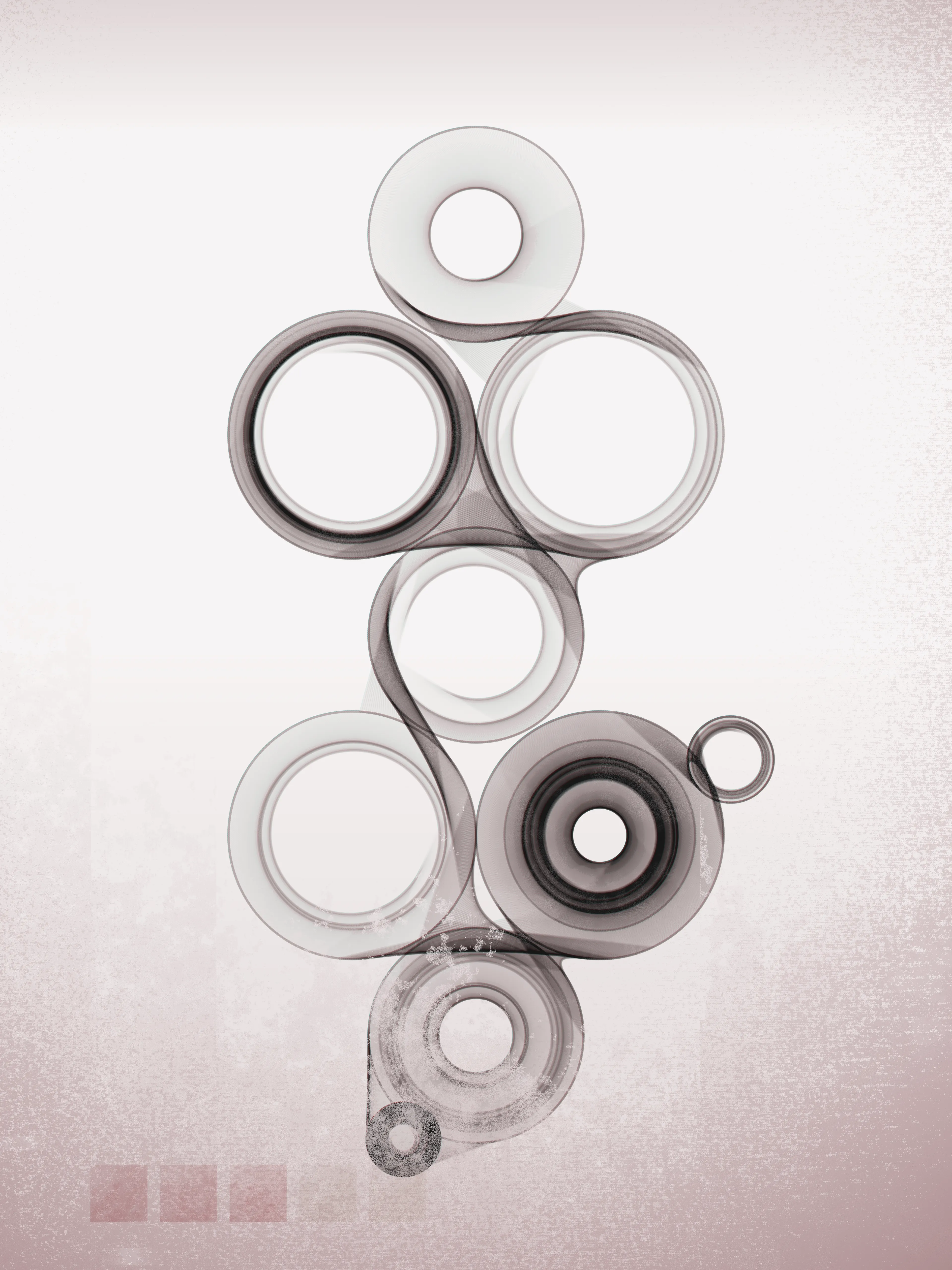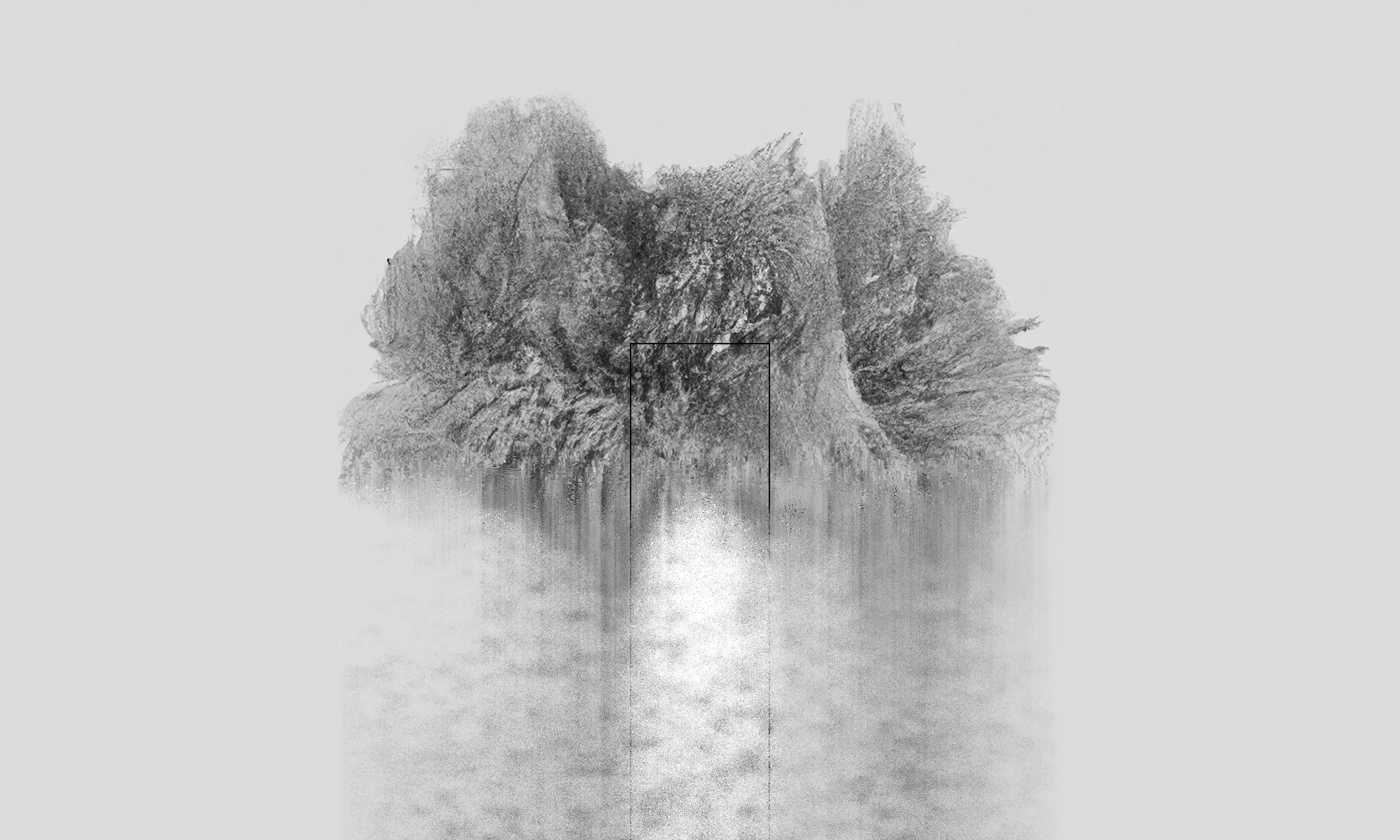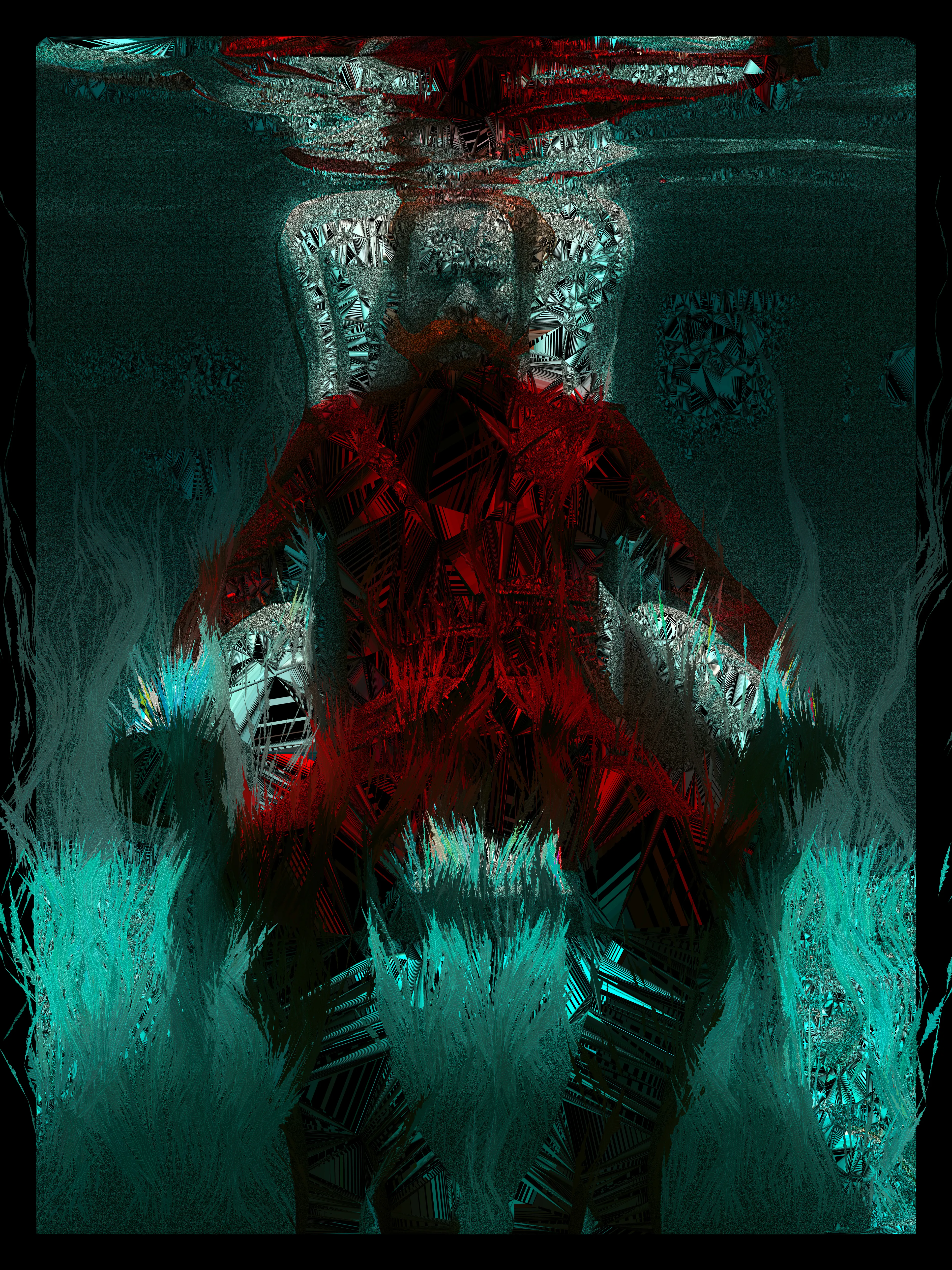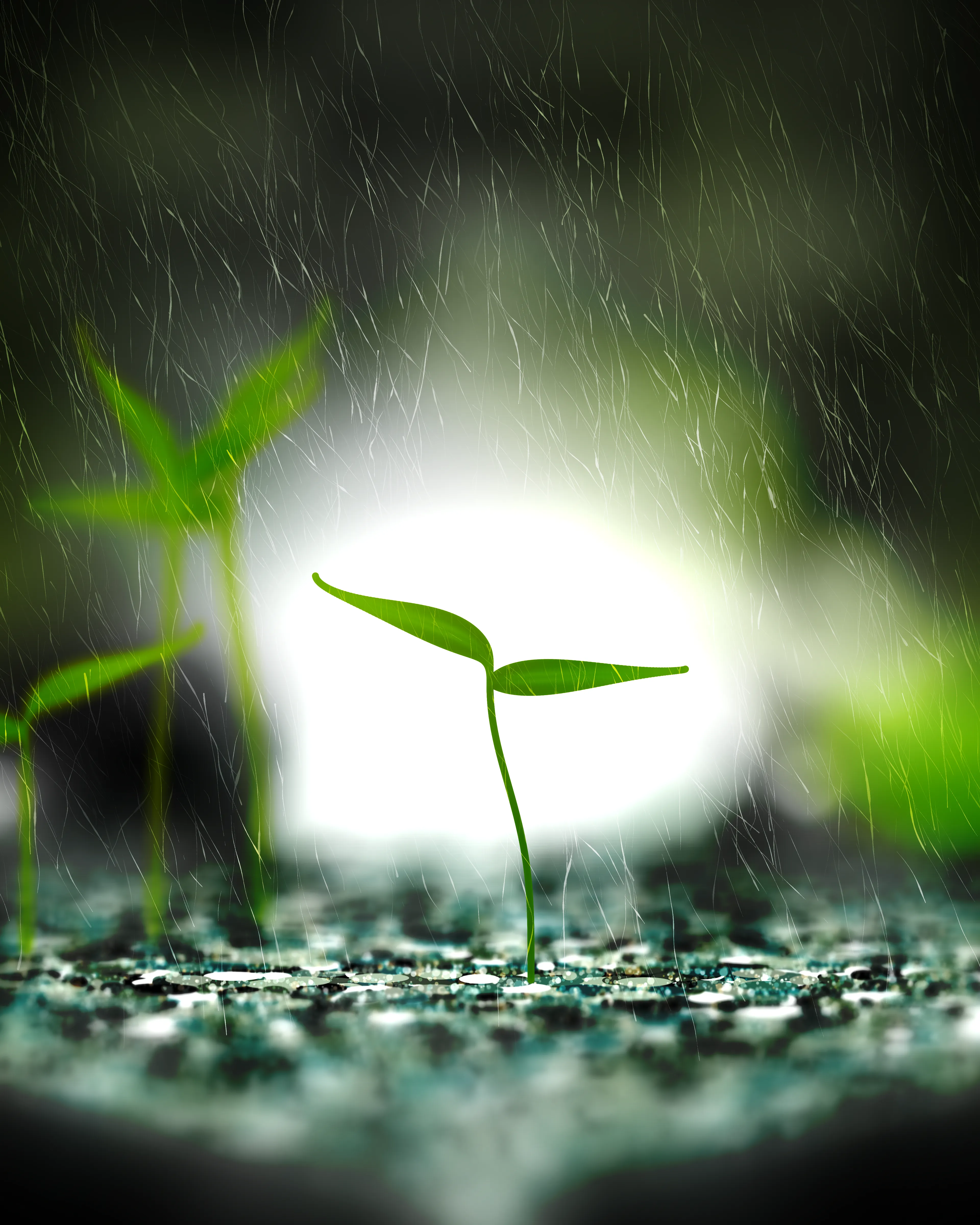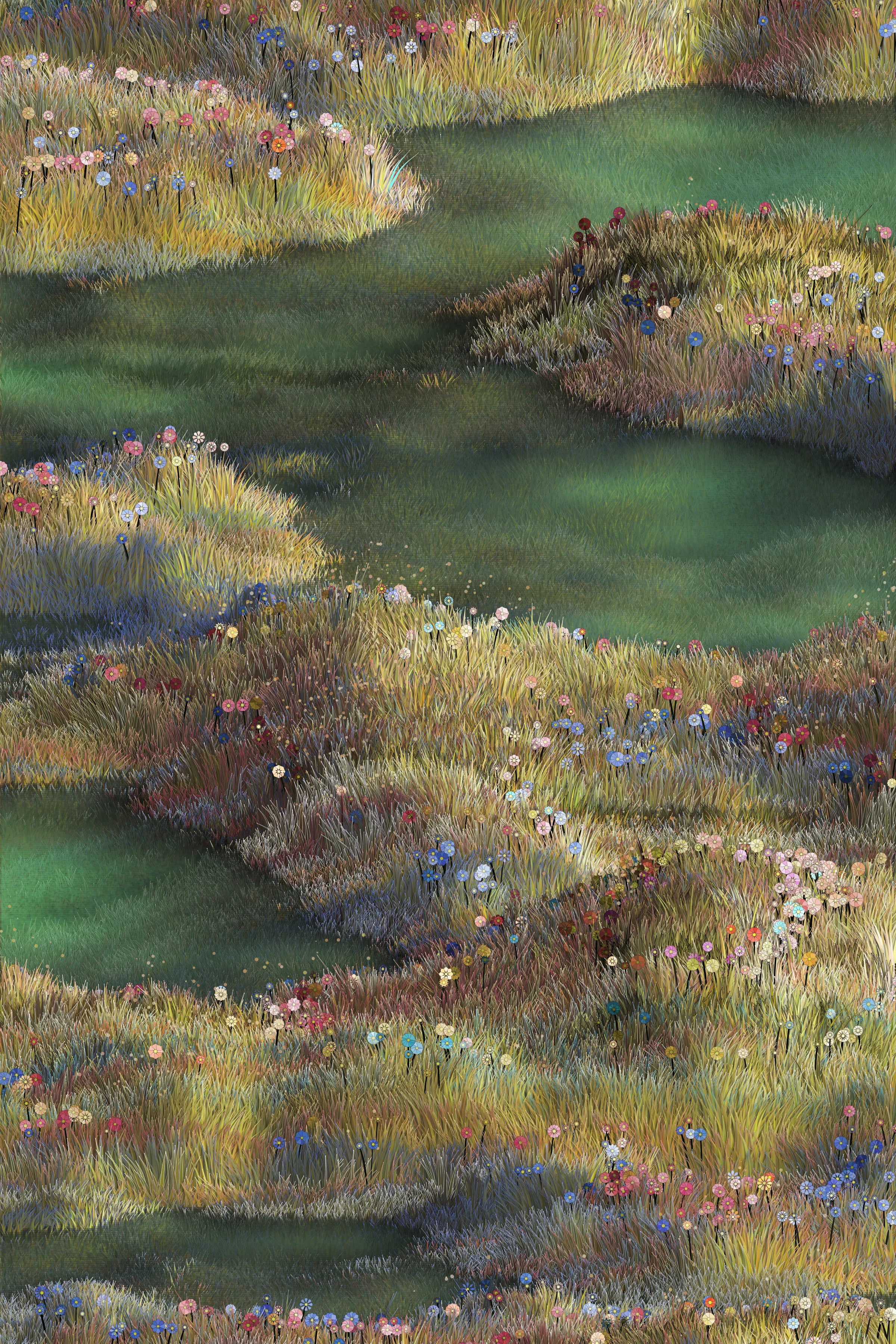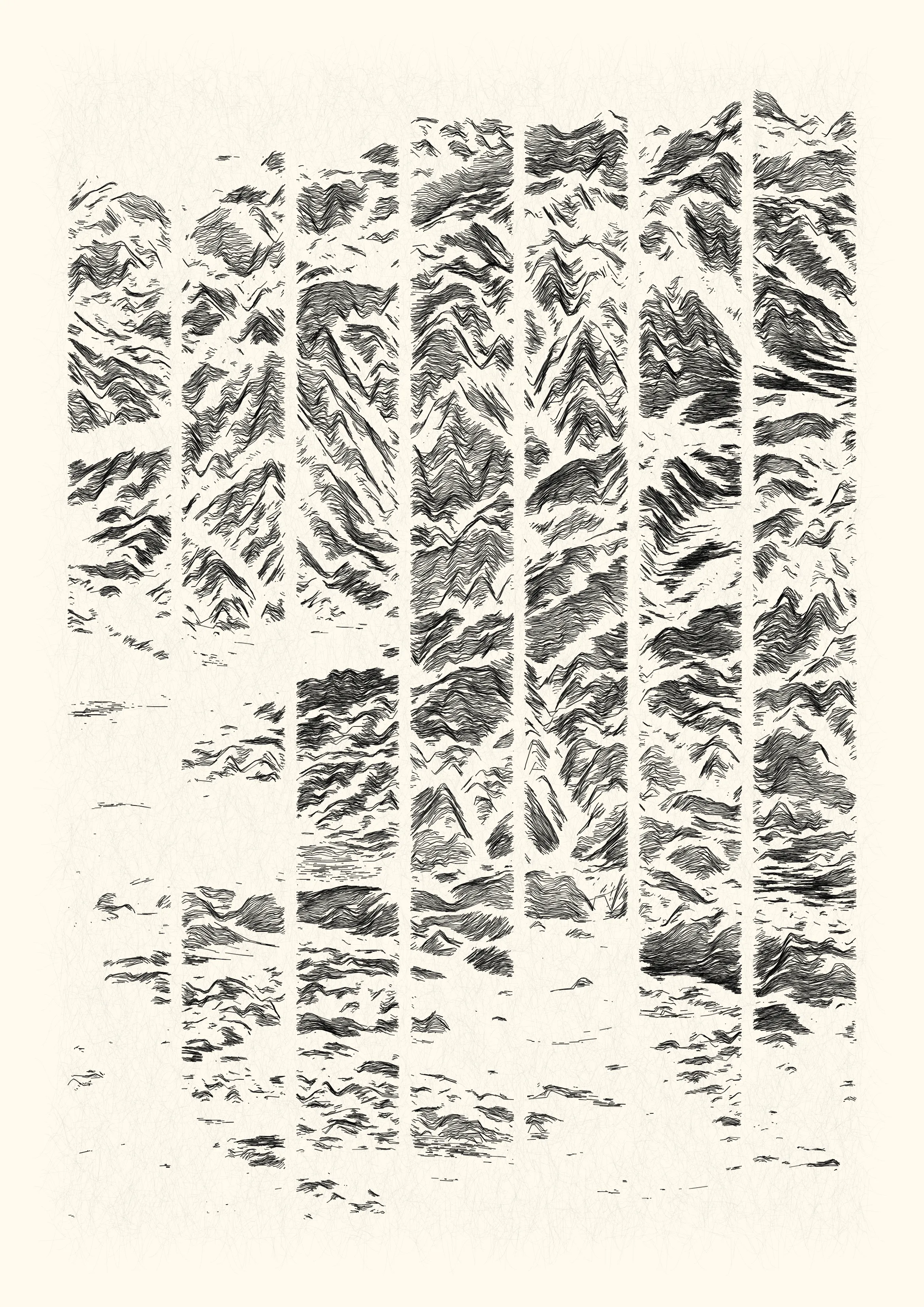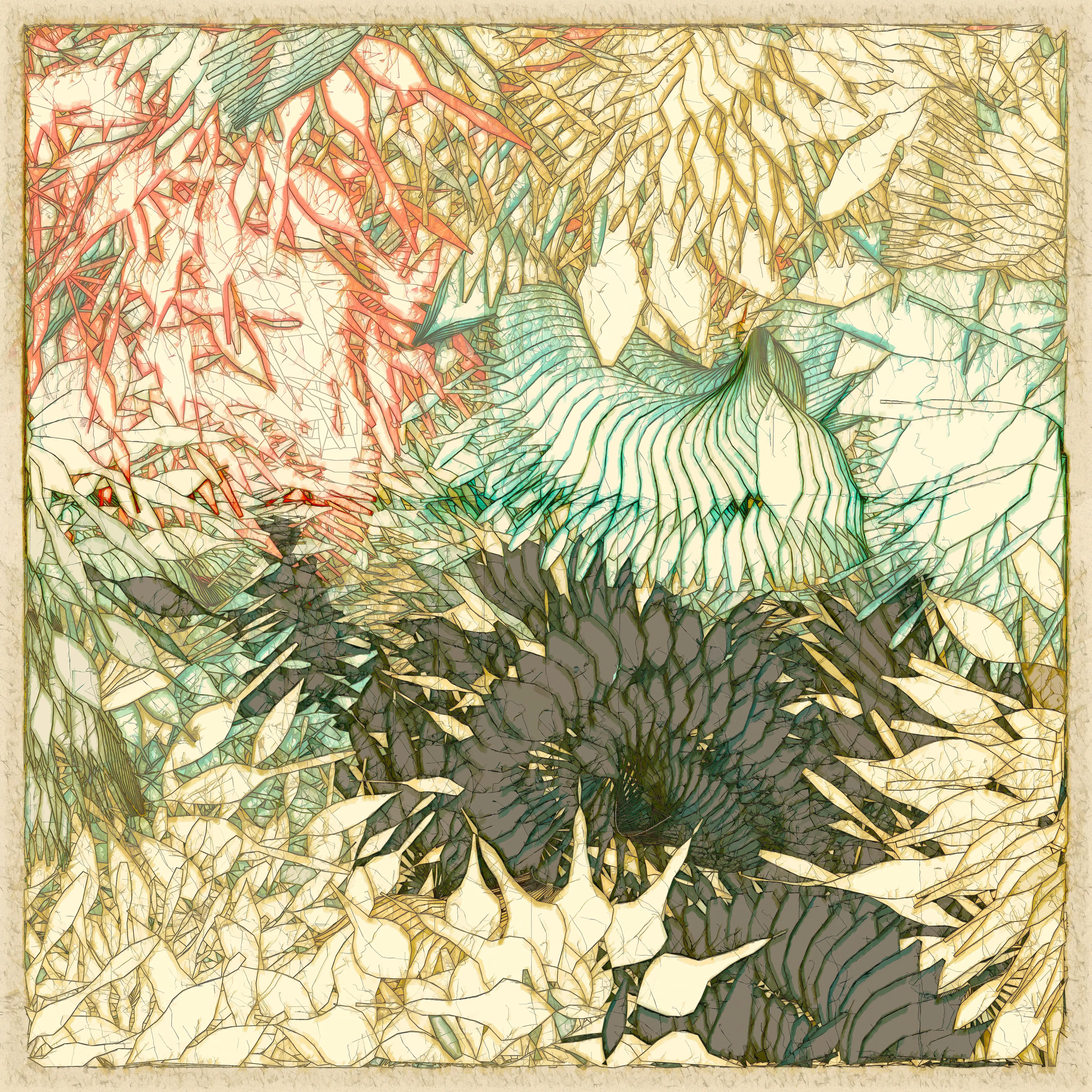Subscribe to get the latest on artists, exhibitions and more.
The Wonders of Recreating Nature
Verse speaks to curator and artists of Arithmetic Phenomena.
Leyla Fakhr: Welcome to Verse! We are extremely excited to show your work in Ronen’s finely curated exhibition. I’d like to kickstart the questions by asking you about your individual practice?
Ryan Bell : In my work, I really enjoy exploring & combining very different techniques and artistic tools -- I have a hard time staying in a lane. The hope is that there remains some unifying aesthetic across projects as they all come from the same person/place. For this piece on Verse, I'm wanting to find an intersection between intentional generative processes and what I'm viewing as AI Photography or a sort of synthetic photographic process, and the changing balance between man & nature as affected by technology. Hoping it ties together nicely.
Pablo Alpe: My process starts generating an organic particle system using glsl and then generates different variations using AI… then I add new ideas with glsl. This is how it is going.
Ronen Tanchum: The dialog between genArt and AI is super interesting to me, where both tools are generative at core and cloud AI is a very powerful tool for conceptual, process or dialogue of the artist rather than a final output.
Pierre Casadebaig: Since the audience is limited, I’ll have a dumb question when you mention AI, you use trained models available in various API or online notebooks? Is it a thing to train its own model, so that it is "more" a personal part of the artistic process (not for huge deep-learning models, of course)?
Melissa Wiederrecht: I used AI for a prompt image for myself . This seems to be a common theme emerging.
Ronen Tanchum : Any of the above, but popular AI tools such as dall-e and Midjourney are becoming very popular these days, though training your own model is much more customizable.
Pierre Casadebaig: In a word, I'm curious about AI output trained on artists minds rather than global hive mind (even if you can feed it personal things).
Ronen Tanchum: I’m interested too. I feel like these tools are just at their early stage atm and there is so much more to them when in dialogue with visual artists both as database and inputs.
Ryan Bell: I've gone both ways on it myself. I've considered building a large "rig" (say $5k+ on something with decent GPUs), but have stayed pretty content with Google Collab Pro that sort of paygos it. The latest offerings from OpenAI and the like have very attractive licensing and unreachable levels of compute, so I'm in that camp now.
Using a stack of upscalers, I've found I can get the detail higher than via 3D, where it's very much a synthetic photo. But I don't have much control over the scene, quite similar to taking a photo of a landscape -- you don't get to light or make the landscape, you just frame it. So days, weeks.. months spent just exploring and capturing the right moment from the machine's mind.
Where a traditional artist would then paint the scene with oil or whatnot, I'm approaching it with geometric shapes + algorithms. Using a stack of upscalers, I've found I can get the detail higher than via 3D, where it's very much a synthetic photo. But I don't have much control over the scene, quite similar to taking a photo of a landscape -- you don't get to light or make the landscape, you just frame it.
Pierre Casadebaig: I think I understand your position, both in terms of hardware required to get to this "own model" step but also in what drives your creative process in exploring this (latent) space.
From my newbie point of view, I can relate to the normal 3D space, described by large datasets - and my interest was to frame a view and erode the data, so that it loses its realistic feeling. So hard to infer the result without trying, i can't imagine with a space with more dimensions.
For verse, I reacted to the "adaptation" part of Ronen Tanchum prompt. Wondering how one can adapt its own tools after reading or seeing something that catches your interest. In this case it was a particular comic with a nonsense yet intriguing feeling ( "Vers la Ville" by Tom Gauld). So, I hope it feels more like a tribute than imitation, but it was a fun exercise to sharpen digital tools for figurative outputs.
Leyla Fakhr: What I love most about Ronen's curatorial approach is how each and every one of your practices are so different. Such interesting points made regarding the dialogue with the machine.
Melissa Wiederrecht: I think for me there are several parts to it: * Generative Art allows for the artist to include randomness into the process, which very often makes for surprises in the art that even the artist did not foresee. In a way that makes it similar to nature - there are rules and systems that govern the way things work (plant a seed in the ground, give it water and light, and you are likely to get a plant), but there is also randomness (where that seed landed after blowing in the wind and the environment it grew up in shapes how the plant grows and what it looks like in the end). So what we often do in Generative Art is create a system that has rules but also has degrees of freedom for the computer to try things that the artist might not expect. *
There is a certain amount of precision and mathematical accuracy that Generative Art provides that it would be hard to get into any other way. With code, we can visualize mathematical formulas, processes, and algorithms, in a way that is not possible with other art tools. * I appreciate that Generative Art allows me to build a system that can generate an infinite number of outputs that all follow the same rules but are all unique. * Personally, my brain thinks in algorithms and code. So for me Generative Art is a form of artistic expression that my brain works with well. If you handed me a paper and pencil or a canvas and a brush, I wouldn't be able to pull off art nearly as well as I can with code. There are probably more aspects to why I use code as a tool for artistic expression, but that is what I can think of right now.
Somebody (who is not me) should probably point out that generative art is the artistic medium of our time where everything is run digitally with code. It may be true, but was not a reason for me to get into it.
Then there is the aspect of blockchain technology itself - which has added a whole new layer on the generative art discussion - and has provided generative artists with a means to earn income that natively matches where we are at with the code and in digital space.
Ronen Tanchum: Great insight Melissa ! To me what is fascinating as well is the unexpected and playfulness of the medium, where it's not a straightforward linear process where the artist goes from nothing to a single artwork rather, with generative tools and code the creation process becomes more of a set of rules that starts with endless options and the artist works to narrow down the options from infinite to the desired output, like backwards engineering
Pierre Casadebaig: I'd go for a pragmatic answer, i did not practice drawing but i knew how to explore data with code for a living. The lock-down restrictions made it click for me. I could kill two birds with one stone : use these skills for artistic exploration and also restore a bit of the creativity that was eroded by management functions. The meaningful things in this process for me ? to be forced to "externalise" parts of the creative process, i assume it's easier to stop, reflect and iterate than if the whole thing happened in my head. Also you could positively get surprised by bugs or errors.
Ryan Bell: I wrote my first program around 8 -- in grade school, and was often asked to stay after class to help the computer lab. While the other kids had a pretty casual understanding of the software, I was hacking resource forks and noodling in assembly decompilers. Been in the scene ever since, where it's hard to imagine purely analogue approaches to most things.
Specifically with art, I find the digital space has a stronger resonance with this background / drive toward technology, and gives me a much deeper range of expression than I can otherwise achieve.
There's a bit of an exploration/inventiveness too in the digital space that isn't found elsewhere. E.g., there's no real analogue to exploring the outputs of cellular automata on paper or stacking functions into increasingly powerful tools.
M. J. Lindow: I first began programming as a supply chain intern looking for ways to be more efficient at completing the more mundane tasks I was given. I was fascinated by the ability to write a program that could condense a multi-day, manual process into several seconds and do it with greater accuracy and at a larger scale than was humanly possible.
I have enjoyed painting and drawing since I was a kid. However, I often feel frustrated by how slow the process can be. By expressing an idea through code and handing the execution over to a machine I can explore ideas more deeply. With a few simple edits, I can take a project in a completely different direction and instantaneously see dozens of variations on a given theme. Also, there is something magical about watching as a never-before-seen image seems to spring from nowhere onto my screen. The feeling of surprise and discovery makes this medium a joy to work with.
Kira0: I started programming in my early years with scripting. I was fascinated by computer automation tools and how it works, especially the idea of being able to operate things without the need for human intervention. Later with the university, I pursued architecture and tried to merge it with programming medium which is where I deep dive into the art aspect and started making various worlds, cities, and landscapes parametrically. What made me attached to generative art is watching a non-human machine creating mesmerizing things within my range of restrictions, endlessly.
Ryan Bell: There's a bit of an exploration / inventiveness too in the digital space that isn't found elsewhere. E.g., there's no real analog to exploring the outputs of a cellular automata on paper or stacking functions into increasingly powerful tools
M.J. Lindow: The ability to stack functions to create artistic systems is reminiscent of LEGOs to me.
Pierre Casadebaig: Big libraries would be the recent smooth shaped bricks, while people coding without these would use the equivalent of the old bricks to achieve great constructions ? one type of construction gives you more control while the other gives fast results ?
Ryan Bell:Admittedly, I'm a bit of a 70-90 hour work week kind of guy, always in software engineering, where training for years sounds about right.
I find intuition comes in the form of taste. You can really create endless possibilities, and each decision influences the choices further downstream. Having a really nice set of outputs requires making a lot of good decisions, even when you're not sure exactly what the final result looks like.
For verse, I wanted to frame an AI-generated character and weave them into a generative scene (this is my first experimental piece to really combine these two separate art forms.) In the research phase, I scanned through hundreds of prompts and variations on variations, always picking my favourites, then favourites of the favourites -- this alone took weeks of scouting. This came before having the final direction for the project to connect it with a theme of nature, just going by the intuition of what might look interesting further developed.
Ronen Tanchum: This is an interesting point, I feel like it's the same with digital tools though, sure it does not come in one day like some of you have been saying. It could take years to master a single technique and a lot of learning and iterative process to be able to execute concepts and visions with code, especially when trying to recreate something that is organic. I’ll add to Leyla Fakhr:’s question another thing that really interests me about your practice for this exhibition. Where did you take inspiration for your pieces? And how did you start the process of creating them, what was your first step and how is it different from previous works you did?
Pierre Casadebaig: You are right that algorithmic art is probably too focused on technology, maybe because it's a more tangible subject for exchange (like "physical" artists talk to master gestures and supports ?). The need to master composition, to "practice" its taste (or to let chance happen) is of course present. Probably easier to train itself because it's rather easy to generate lots of variations, as most of the other artists indicated.
I reckon that the appeal of generative art is to design algorithms whose emergent properties can surprise artists and audiences alike while maintaining a long-form meaning. However, I'm curious about generative art as an evolutionary process (random generation, selection, adaptation), where artists can patiently collect interesting seeds in the hope of evolving them into something new, independently of the mindset of their creation. But the pace of this scene is amazing, everyone is evolving so fast!
Ronen Tanchum: This is an interesting point, I feel like it's the same with digital tools though, sure it does not come in one day like some of you have been saying. It could take years to master a single technique and a lot of learning and iterative process to be able to execute concepts and visions with code, especially when trying to recreate something that is organic. I’ll add to Leyla Fakhr:’s question another thing that really interests me about your practice for this exhibition. Where did you take inspiration for your pieces? And how did you start the process of creating them, what was your first step and how is it different from previous works you did?
Kira0: I usually start with the wildest sketch I can make to open up the possibilities and then tame it until its fitness value comes close to my desired aesthetic value. It is more like a sculpture where you start from the basic cube and shape it slowly. My inspirations are the biggest factor since I am from a country surrounded by various natural scenes which you can experience all 4 seasons. This is where I am now. Inspiration loading.
Ryan Bell: Hopefully this isn't too far out into left field, but this is the direction I went with mine: NEPTUNE RISING Before modern science and meteorology, people once believed that Neptune, god of waters and seas was responsible for the terrible storms that sailors fought at sea. Over the centuries, a feedback loop toward greater technology and higher energy usage has transformed man into Neptune. Now bearing the evidence that our species is both responsible for and being called upon to save the planet and all other known forms of life from irreversible drought, famine, and extinction, will mankind accept this challenge and rise to heal the environment or sit idly, distracted, and wait for its destruction?
Ronen Tanchum: The level of detail in this photo when zooming in is incredible! I love that it’s made of small leaves while keeping the underwater feel, also a very interesting concept.
I Had a lot of fun with the subtle seaweed swaying up to the surface. Almost like a flame made of water rendered with plants...
I have always been passionate about mathematics and physics. I started real programming at the University where I studied electronic engineering. My goal was to design guitar effects pedals since I was playing in several bands at the time. On the other hand, the world of art and drawing had always fascinated me, so I started using code in an artistic environment and since then I have not stopped creating interactive art with Vitamin Studio, generative projects, and code-based pieces. What fascinates me the most about using code to create art is the immensity of possibilities and how a simple idea can evolve into something you hadn't thought of at first
Melissa Wiederrecht: I think for me, intuition is just as important in generative art as in any other art. I view my code and techniques as tools to portray what I am getting at, and I control the randomness as just another tool. I open the bag of randomness only in the way I want it and not allow it to take over any part of the process except what I intend for it to. I know a lot of generative artists would view it otherwise, but that is how it is for me. I tend to be very intentional and intuitive in my art even though my particular tools are indeed logic, math, randomness, noise, etc.
Ryan Bell: Hopefully this isn't too far out into left field, but this is the direction I went with mine: 'NEPTUNE RISING'. Before modern science and meteorology, people once believed that Neptune, god of waters and seas was responsible for the terrible storms that sailors fought at sea. Over the centuries, a feedback loop toward greater technology and higher energy usage has transformed man into Neptune. > > Now bearing the evidence that our species is both responsible for and being called upon to save the planet and all other known forms of life from irreversible drought, famine, and extinction, will mankind accept this challenge and rise to heal the environment or sit idly, distracted, and wait for its destruction?
Ryan Bell: My process in general is pretty chaotic. It's a search for a unique aesthetic that I can further develop and elaborate on. I set an intention, begin typing, and see where the art + code leads, which is often a winding path with forks in the road / codebase (e.g., backup_backup_04_final_final.js). I'm thinking about texture, contrast, precision, variation, symbolism, etc. Out of my recent AI sketchbooks with hundreds of characters, only ~3 of the individuals met that bar for me of being worth elaborating and expanding upon.
There's a woman with a striking image of being superimposed with a wooden set of stairs that just gives me this sense of being stuck. Another that is just absolutely hilarious. And, there's this man in a bright red shirt, submerged under a teal ocean, sitting in a chair -- it's just a striking image. Connecting with the theme of this exhibit, which is all about that intersection between technology and nature, this man's presence felt strong enough to associate with Neptune.
(I love Greek mythology! I traveled to Athens recently and really soaked it in.) Leaning on some new ideas ("hey, maybe I can sketch him with a flow field and do an impressionistic rendering with leaves to create seaweed?") and following that where it leads.
Looking at my 4yo nephew, there is a sense that this is a generation which will be uniquely called upon to save the environment, where previous generations didn't bear that weight of the near-term consequences.
It's also kind of an interesting step toward becoming a Type I civilization in terms of technology and global impact. There's a story of looking up to some mythic being which would have these powers, and our species acquiring it.
M.J. Lindow: Writing code requires me to break my ideas into components and wrap them in logic for a machine. In that sense, my process is very ordered and logical. However, I find intuition is critical in creating my work. For each project, I feel I am charting a course through the random permutations presented by the machine to an outcome that aligns with my vision. Intuition serves as the compass helping me determine which paths to explore in the next iteration. In that way, it is also an evolutionary process where new possibilities arise from the code, but are selected to continue based on how I feel they contribute to the overall potential of the work.
I agree, developing the tools and techniques for creating organic images with code is not something that happens overnight. A great deal of work goes into it.
There are two main sources of inspiration for this work I can identify. I recently began the practice of slowing down while trekking through the wilderness, to pay closer attention to the sea of plants surrounding me. Examining the biodiversity found in seemingly mundane patches of growth has become a new source of awe for me. On closer inspection, the ground at my feet becomes a world full of diverse species, each one an intricate algorithm perfectly adapted to its niche.
I tend to focus on the more imposing features of landscapes that strike awe in an entirely different way. In past projects I have included vegetation, but it has never been the main focus of the work, choosing instead to focus on mountains and rock formations. As my starting point for this artwork, I borrowed elements from previous projects, but stripped away the imposing geological features and emphasised the tangled grass and wildflowers.
Finally, I wanted to celebrate the subtlety of autumn. As summer comes to a close at the lower elevations, the once vibrant, saturated colors have become muted. I wanted to create something that would capture the calmness in the rustling fields and foothills around me, as the seasons change.
Melissa Wiederrecht: I had a ran dom idea to try to make an image of a tiny plant sprout. So I went and explored on mid journey for a while until I found an image I liked and then I basically did my best to copy it in code. But then I went in and added variation to that image, adding more sprouts, letting the lights in the background move around, etc. This way the final result would not be exactly like the inspiration image, while still be inspired by it. This piece is actually quite different than any previous work of mine in subject matter, but the tools I have used are the exact same tools I use in all my works... random ellipses, variable blurs, random wiggly lines, etc.
Pablo Alpe: This collection is based on the sensations and thoughts I have when witnessing the dispersion of sunlight in the atmosphere, the shades on the cliffs, or the generative meditation and movement of the sunlight on the sea. My idea for the exhibition is to create 5-10 outputs using the same idea and technique. For these pieces I mixed code-based techniques and different AIs in order to represent Nature in different abstract scenarios. The process: I create several sketches that represent feelings I have when in contact with nature. Some are fast sketches and others are "complex simulations" like fluids/smoke created using different SW and different code-based techniques. Once I have enough ideas and sketches I share and discuss everything with different AIs until we understand each other and agree on how to simulate specific scenarios. The result is then optimized using shaders to reinforce the concept and to add some post effects like glass refraction or sea reflection. These are some of the sketches, I used to create some of the outputs.
Pierre Casadebaig: As an aspiring artist, for this exhibition, I wanted to practice composition. Instead of working on one iteration, I tried to lay out several ones, with an element from another system. I'm quite sure there is something to gain to assemble several systems (eventually with interactions) but I'm not there yet.
M.J. Lindow: There are two main sources of inspiration for this work I can identify. I recently began the practice of slowing down while trekking through the wilderness, to pay closer attention to the sea of plants surrounding me.
Examining the biodiversity found in seemingly mundane patches of growth has become a new source of awe for me. On closer inspection, the ground at my feet becomes a world full of diverse species, each one an intricate algorithm perfectly adapted to its niche. I tend to focus on the more imposing features of landscapes that strike awe in an entirely different way. In past projects I have included vegetation, but it has never been the main focus of the work, choosing instead to focus on mountains and rock formations.
As my starting point for this artwork, I borrowed elements from previous projects, but stripped away the imposing geological features and emphasized the tangled grass and wildflowers. Finally, I wanted to celebrate the subtlety of autumn. As summer comes to a close at the lower elevations, the once vibrant, saturated colors have become muted. I wanted to create something that would capture the calmness in the rustling fields and foothills around me, as the seasons change.
Leyla Fakhr: Amazing how you take inspiration from the intricacies of nature. We often overlook the most complex compositions that are exactly in front of us. Also, thanks so much Pierre. Interestingly - the responses have been not too different to artists I have worked with in the past.
As I was reading about the processes it became clear to me that many artists are extremely connected to unconscious levels that help them develop their work. So not being exactly able to articulate the final piece from the start, but knowing what it is when it is there. I think that is beautiful!
This journal article was created from a Discord chat with the artists and curator of 'Arithmetic Phenomena'.
Ronen Tanchum
The longing and a connection to nature are at the basis of the curation practice by the artist Ronen Tanhum. Tanchum works at the intersection of art, technology and interaction, between the physical and the digital and between the planned and the random. He takes Inspiration from organic behaviours alongside mathematical processes occurring in nature, and presents his interpretations of these...
M.J. Lindow
Is a generative artist from the western United States. Inspired by art from an early age, he was constantly drawing and painting. To pay for college, he designed and built stained glass windows at a local studio. While at school he became fascinated with code and its ability to multiply human capability and later worked as a data engineer and data analyst building scalable systems to improve human...
Kira0
Is a multidisciplinary artist, researcher, lecturer, and architect from Turkey who experiment with digital fabrication, parametric modeling, videomapping, interactive and generative art.
His works are composed between architecture and nature and are inspired by randomness and wildness of everyday life. Kira0's works are mostly created with generative/parametric methods by using computer...
Leyla Fakhr
Leyla Fakhr is Artistic Director at Verse. After working at the Tate for 8 years, she worked as an independent curator and producer across various projects internationally. During her time at Tate she was part of the acquisition team and worked on a number of collection displays including John Akomfrah, ‘The Unfinished Conversation’ and ‘Migrations, Journeys into British Art’.
She is the editor...
